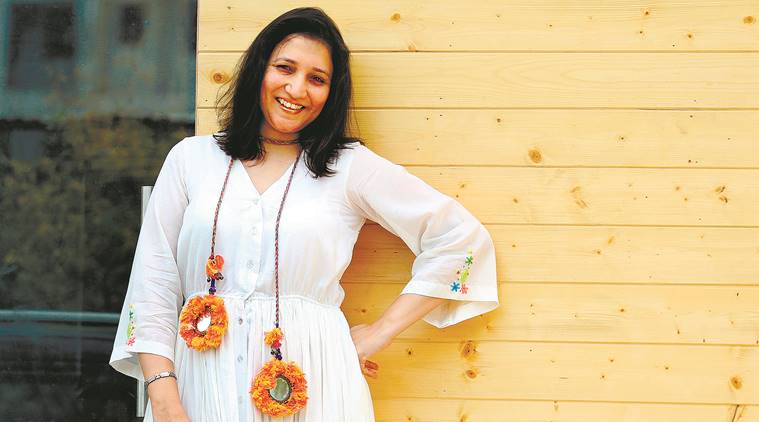Girls are Coming Out of the Woods
Who do we talk about when we speak of gender warriors in India? A new book has some answers

Aparna Jain (Express Photo by Amit Mehra)
In 2016, when Aparna Jain came to know about a Kickstarter project for a book that would profile 100 phenomenal women from around the world, she promptly invested in it for her niece. That book, Goodnight Stories for Rebel Girls, would go on to kickstart a revolution of its own, opening up a global conversation about the kind of icons that young girls — and boys — need in their lives. It would also encourage Delhi-based Jain, writer, painter and a leadership coach, to take the plunge and come up with her own volume of extraordinary Indian women — Like a Girl: Tough Stories for Tough Kids (Context, Rs 799, appropriate for: 10+ years), Jain’s third book after the delightful The Sood Family Cookbook (2013) and Own It: Leadership Lessons from Women Who Do (2016).
When is it a good time to speak to a child about ethnic and religious diversity? Is seven a good age to start talking to them about sexual violence? When Jain’s close friend and mother of a seven-year-old girl posed the question to her, Jain says she hesitated for a minute. “They were watching The Kite Runner on television and my friend wasn’t sure if she should allow her daughter to see the sequence portraying Hassan’s rape. But then we thought, children younger than her face sexual violence all the time. Why should one not prepare her for the seamier side of life?” says Jain, 48, when we meet her at Cafe Dori in Chattarpur.
“Aparna told me about Rebel Girls and brought a copy for me to look at, sometime in mid-2017. My colleagues and I were instantly taken with the idea and yet concerned about how to go about doing an expensive all-colour book… It was hard to publish these in India because of the high costs of origination and the continued insistence on low price points. Then came the other major shift: teachers and schools, not all but some, began to speak to kids about things closer to home in more real and grounded ways, not shying away from issues of difference, inequality and gender. There aren’t enough books addressing these in an Indian context, in ways that both educators and children can access. That’s the gap we hope to fill with books like Like a Girl,” says Karthika VK, publisher, Westland.
The choice to talk “tough”, says Jain, was a foregone decision. “India works very differently than any other place in the world. Here, feminism can mean the right to marry whom you want, to have better working conditions or simply to demand justice for the wrongs done to you. Often, the kind of elitist feminism we preach in cities piggy-rides on the many challenges that women at the grassroots face and fight. I thought it was important to introduce kids to people who come from a different time, place and background, women they are not familiar with and whose way of life is very different from their own,” she says. The 56 women she has profiled — from Sultan Razia to Rukhmabai Raut, one of the first practising women doctors in the country, whose stand against child marriage had resulted in a landmark decision, to politicians Indira Gandhi and J Jayalalithaa; from activists Rashida Bi and Champa Devi Shukla demanding justice for the victims of the Bhopal Gas tragedy to musician Kishori Amonkar; from sportswomen Saina Nehwaland Dipa Karmakar to tribal activist Dayamani Barla — cover a wide spectrum of India’s sociopolitical life.
There is also focus on inclusivity in the book. Through profiles of Dalit leader Mayawati and writer Bama, mental health activists Vandana Gopikumar and Vaishnavi Jayakumar, transgender activist and mother Gauri Sawant, Jain explores issues such as mental health, caste and gender identity that are never fully realised in narratives for the young. There are some surprise inclusions, too, such as restaurateur Ritu Dalmia. “I had a lot of feedback when I was writing the book and many people pointed out that including Dalmia might be elitist. But, to stop formal education at 16 and take on a male-dominated industry, to come out to a conservative Marwari family as a lesbian, take courage and I had no hesitations about her inclusion,” says Jain, whose research included meetings with the women or their family or descendants and reading up on them.
The book’s approach, says Amitabh Behar, CEO, Oxfam India, art patron for the project, is what drew them to the project. “…There is enough evidence that children begin to notice gender differences in preschool. They exhibit gender stereotype and associate traits or attributes such as ‘gentle’ or ‘adventurous’ with particular genders. We must break this belief system. We were extremely excited when Aparna reached out to us last year in December. The project aligned with our vision to create positive social norms through mass mediums,” says Behar.
From feisty watercolours to delicate cutwork, one of the highlights of the book, that took six months to be completed, is the rich pool of illustrations done by 27 women artists for each of the women profiled. There is also a reading guide at the end that explains some of the themes it explores, including caste, sexual violence and gender identity. “That was one of the toughest parts of the project and I did think a lot before talking about Bhanwari Devi’s rape or the caste discrimination faced by women such as Mayawati or Bama. But then I decided to go with it. I hope that this book becomes a tool that one uses to have those difficult but stimulating conversations with one’s children,” says Jain, who is now working on a companion volume to the book.
For all the latest Lifestyle News, download Indian Express App






















No hay comentarios:
Publicar un comentario